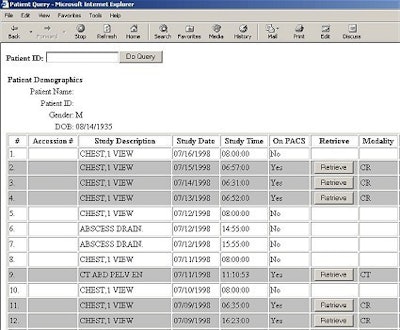
If you’ve ever come to the end of a map before you arrived at your destination, you know what it’s like to run out of diagnostic data at an inopportune moment. It’s the same with the radiological studies that are part of a patient’s medical record: When an image is added, it becomes a key part of the patient’s care, contributing detail to the particular map of the person’s body. If part of that map is missing, it’s easier to take a wrong turn.
Graduate student researchers at the University of California, San Francisco’s Laboratory of Radiological Informatics in the department of radiology are addressing the concern that doctors may be missing pieces of a patient’s medical record if the PACS and RIS at a radiology department or imaging center are not integrated.
When a radiology department adopts PACS, it faces the issue of what to do with existing film studies; when radiologists don’t compare PACS images to relevant film archives, they open themselves to malpractice suits. In the March 21, 2003 issue of the Society for Computer Applications in Radiology’s online publication, the Journal of Digital Imaging, Wyatt M. Tellis and colleagues present a tool they’ve developed to integrate PACS and RIS.
Tellis suggests that, with slight modifications to commercial software, Web-based integration methods can help radiologists find relevant film studies in the RIS and compare them to current digitized studies in the PACS from any diagnostic workstation, improving both workflow and patient care.
Because most RIS and PACS use separate databases -- RIS knows all studies performed, while PACS only knows those in its own system -- physicians must interrupt their work at a diagnostic workstation to query a separate RIS terminal, or use a special RIS window in the workstation. Although most PACS have some measure of RIS integration, the system’s retrieval of prior studies is usually limited to studies in the PACS.
But many RIS do not or cannot distinguish between studies on film and those on PACS. Tellis and his colleagues created a Web-based integration system that would query both the RIS and PACS, and then assimilate the results using the following set operation:
[set of film studies]=[set of RIS studies]-[set of PACS studies]
A radiologist begins an inquiry with a Web browser on a display station. The patient’s medical record number is used to launch the browser, which connects to a Web server that hosts a Java Server Page (JSP) that performs a DICOM query of the PACS and an HL7 query of the RIS, and then collates the results using the above set operation.
These modifications to DICOM and HL7 are done in-house with Java-based toolkits. Results are returned to the user’s browser as an HTML page that outlines which studies are on PACS and which are only on film.
Tellis used three JSP (Sun Microsystems, Santa Clara, CA) pages running on an Apache Web server with the Tomcat JSP Engine. To write the JSP pages, they used Forte IDE (Integrated Development Environment) software from Sun. They also developed Java-based DICOM and HL7 toolkits, embedding DICOM and HL7 queries into the Web page, which streamlined the design and development of the tool.
To gather user and quality assurance data such as measurements of the system’s performance and activity such as page access times, query times, and user identities, Wyatt used an Access database (Microsoft, Redmond, WA) and the RmiJDBC driver to apply the Java Database Connectivity (JDBC) connection to Access.
To handle interaction with the RIS-PACS query tool, they embedded a Web browser into the PACS display station software (Impax R4, Agfa HealthCare, Ridgefield Park, NJ). The browser uses the vendor’s own scripting language to determine the clinical context (patient ID and accession number) and to communicate this context to the query tool using a standard URL.
The URL shunts to a JSP page that performs the DICOM query of the PACS and an HL7 query of the RIS for all exams related to the patient ID used before collating the results according to the set operation. PACS-based studies are displayed to the user in gray and film studies are in white.
 |
| The University of California, San Francisco’s Web-based RIS-PACS application distinguishes between studies on film and those in the PACS. Image courtesy of Wyatt M. Tellis and UCSF. |
Because RIS is the primary storage bank of non-image patient data and can be used for other purposes, such as scheduling or billing, it’s usually the first system a hospital or imaging center chooses to install, Tellis said. Having a good RIS solution in place is important for PACS since most PACS rely on the RIS for verification of incoming images, as well as managing worklists and report dictation. But the two systems have to be able to communicate with each other.
"The ideal situation is to have both RIS and PACS driven by the same database," Tellis told AuntMinnie.com. "(The RIS-PACS tool) frees the user from having to worry about the distinction between the two systems by allowing the user to query both systems as though they were one."
Tellis tried the tool for a month, finding an average of 20 queries a day from display stations, 96% of which were between 8:00 am and 5:00 pm, with peaks at 11:00 am and 2:00 pm. The PACS query performance decreased as the day progressed, while the RIS performance improved, which Tellis attributed to the hardware of both the RIS and the server, which hosted the RIS-PACS application. When that hardware was replaced, the trend disappeared, he said.
Tellis plans to continue to refine the tool, streamlining underlying code to automate quality assurance tasks such as recognizing unread exams or exams that didn’t make it to PACS, as well as making the tool capable of sending selected studies to workstations outside of the PACS.
In any case, more tightly integrated RIS-PACS makes everything more efficient, from workflow to patient care to record keeping.
"I anticipate there will be a trend toward much closer integration between the RIS and electronic medical record systems, to the point where the RIS will become a specialized interface --customized for use by radiology -- to the database hosted by the EMR," Tellis said.
By Kate Madden Yee
AuntMinnie.com contributing writer
May 12, 2003
Copyright © 2003 AuntMinnie.com


















